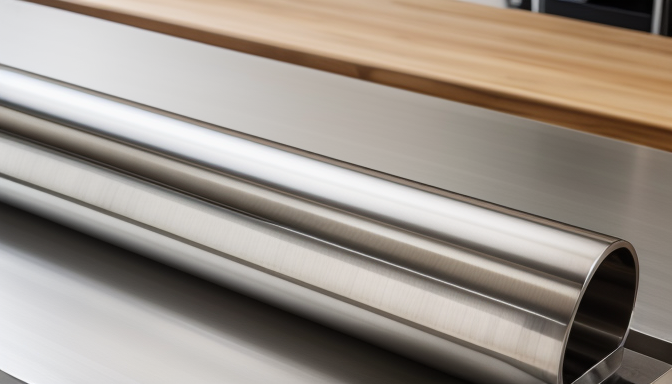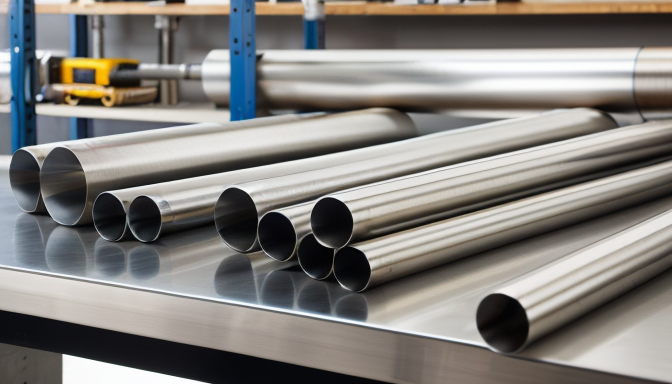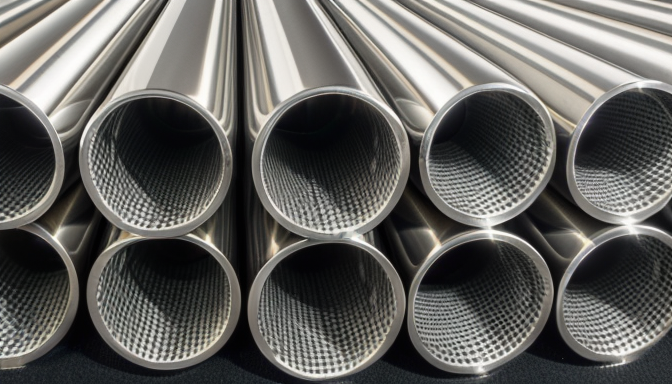When it comes to construction and manufacturing, 410 stainless steel pipes stand out as a reliable choice. Why? Because they blend durability with affordability. These pipes are made from a specific type of stainless steel that contains around 11.5% chromium. This composition gives them a unique edge. They are resistant to corrosion and can withstand high temperatures, making them ideal for various applications.
But what exactly makes 410 stainless steel pipes so popular? For starters, they are often used in environments where resistance to wear is essential. Think of applications like automotive parts, kitchen utensils, and even industrial equipment. Their ability to resist oxidation and maintain structural integrity makes them a go-to choice for many industries.
Now, let’s dive deeper into their characteristics. The strength of 410 stainless steel pipes is impressive. They have a tensile strength that allows them to handle pressure without deforming. Have you ever tried bending a metal pipe? It’s not easy! This strength ensures that these pipes can perform well under stress, which is crucial in construction and manufacturing settings.
In addition to strength, these pipes have a certain hardness that makes them suitable for applications where wear and tear are a concern. They can handle abrasive materials without easily getting damaged. This is why you might find them in places like mining operations or manufacturing facilities that deal with heavy machinery.
So, if you’re considering using 410 stainless steel pipes, you’re making a smart choice. Their combination of affordability, strength, and corrosion resistance makes them a valuable asset in various projects. Whether you are building a new structure or repairing existing equipment, these pipes can meet your needs effectively.
In summary, 410 stainless steel pipes are more than just metal tubes. They represent a balance between quality and cost, making them an essential component in many industries. So, the next time you see a stainless steel pipe, remember the strength and resilience it embodies!
410 Stainless Steel Pipe Price
Understanding the pricing factors for 410 stainless steel pipes is crucial for budgeting and procurement. Prices can fluctuate based on a variety of elements, so it’s important to keep an eye on the market trends. Why does this matter? Because knowing the price can help you make informed decisions, whether you’re buying for a big project or a small repair.
First off, let’s talk about the main factors that influence the price:
- Raw Material Costs: The price of stainless steel itself can vary significantly. When the cost of raw materials goes up, so does the price of the pipes.
- Supplier Variations: Different suppliers offer different prices. It pays to shop around and compare quotes.
- Specifications: Custom sizes or special finishes can increase the cost. Standard sizes are usually more affordable.
- Market Demand: When demand is high, prices tend to rise. Conversely, during a downturn, prices may drop.
To give you a clearer picture, here’s a rough estimate of what you might expect to pay for 410 stainless steel pipes:
| Pipe Diameter (inches) | Price per Foot ($) |
|---|---|
| 1 | 2.50 |
| 2 | 4.00 |
| 3 | 6.00 |
| 4 | 8.00 |
These prices are just estimates and can vary based on the factors mentioned earlier. It’s always wise to check with multiple suppliers to find the best deal. Remember, the cheapest option isn’t always the best. Quality matters, especially in construction and industrial applications.
In conclusion, understanding the pricing of 410 stainless steel pipes is essential for anyone involved in procurement. Keep in mind the fluctuating market conditions, and don’t hesitate to ask suppliers about any discounts for bulk purchases. A little research can save you a lot of money!

410 Stainless Steel Pipe Weight
The weight of a 410 stainless steel pipe is a key factor to consider for anyone involved in construction, manufacturing, or any project that requires these pipes. Why? Because the weight affects everything from transportation to installation. Understanding how to calculate the weight based on dimensions can save you time and money.
To get started, let’s break down the calculation. The weight of a stainless steel pipe can be estimated using the formula:
Weight (lbs) (Outer Diameter - Wall Thickness) x Wall Thickness x Length x 0.2836
This formula gives you a good approximation. However, factors like the density of the material and any additional coatings can slightly alter the final weight. The standard density for 410 stainless steel is around 0.28 lb/in³.
Now, why does weight matter? Here are a few reasons:
- Transportation Costs: Heavier pipes can increase shipping costs.
- Installation: Lighter pipes are easier to handle and install, reducing labor time.
- Structural Integrity: Knowing the weight helps in ensuring that the supporting structures can handle the load.
It’s also important to note that the weight can vary depending on the pipe’s size and wall thickness. For instance, a thicker wall will naturally weigh more than a thinner one. Here’s a quick reference table for some common sizes of 410 stainless steel pipes:
| Pipe Size (inches) | Wall Thickness (inches) | Weight per Foot (lbs) |
|---|---|---|
| 1 | 0.065 | 1.68 |
| 2 | 0.065 | 2.72 |
| 3 | 0.065 | 3.76 |
| 4 | 0.065 | 4.80 |
When planning your project, always consider the weight of the pipes you choose. A little extra planning can prevent headaches down the line. So, whether you’re transporting, installing, or simply storing these pipes, keeping their weight in mind will help you make informed decisions.
410 Stainless Steel Pipe Properties
When it comes to 410 stainless steel pipes, understanding their properties is key to knowing why they are so widely used. This grade of stainless steel is known for its unique blend of corrosion resistance, tensile strength, and hardness. These characteristics make it a popular choice in various industries, from construction to automotive applications.
First off, let’s talk about corrosion resistance. While 410 stainless steel isn’t as resistant to rust as some other stainless steel grades, it still holds its own in many environments. It can withstand exposure to moisture and certain chemicals, making it suitable for applications like kitchen equipment and industrial machinery. Imagine this: if you had to choose a material for a kitchen sink, you wouldn’t want it to rust away after a few months, right? That’s where 410 shines.
Next, consider the tensile strength. This property refers to how much force a material can withstand while being pulled or stretched. 410 stainless steel boasts a tensile strength of around 70,000 psi. This means it can handle heavy loads without deforming. Think of it like a sturdy bridge that can support a lot of traffic without collapsing. This strength makes it ideal for applications where durability is crucial, such as in automotive components and structural supports.
Now, let’s not forget about hardness. 410 stainless steel is known for its ability to be hardened through heat treatment. This means that it can be made even tougher, which is particularly useful in applications where wear and tear are common. For example, if you have a part that is constantly in motion or under friction, using a hardened 410 stainless steel pipe can significantly extend its lifespan. It’s like using a tough pair of shoes that can withstand the grind of daily wear.
To sum it up, the properties of 410 stainless steel pipes make them a versatile choice for various applications. Here’s a quick overview:
| Property | Description |
|---|---|
| Corrosion Resistance | Moderate resistance to rust and chemicals |
| Tensile Strength | Approximately 70,000 psi |
| Hardness | Can be hardened through heat treatment |
In conclusion, if you’re considering 410 stainless steel pipes for your project, you’re making a solid choice. Their combination of strength, hardness, and reasonable corrosion resistance makes them suitable for a wide range of uses. Whether you’re building a new kitchen or designing a structural element, 410 stainless steel pipes can meet your needs effectively.

410 Stainless Steel Pipe Sizes
When it comes to 410 stainless steel pipes, size matters. Choosing the right size can make or break your project. It’s not just about fitting into a space; it’s about ensuring durability and performance. So, what sizes are available? Well, they come in a variety of dimensions to suit different applications.
Typically, 410 stainless steel pipes are available in multiple diameters and wall thicknesses. For instance, you might find pipes ranging from 1/2 inch to 12 inches in diameter. But that’s just the start! The wall thickness can vary, too, which is crucial for determining how much pressure the pipe can handle. This is especially important in industries like oil and gas, where safety is paramount.
Here’s a quick breakdown of some common sizes:
| Pipe Diameter (inches) | Wall Thickness (inches) | Weight per Foot (lbs) |
|---|---|---|
| 1/2 | 0.065 | 0.84 |
| 1 | 0.109 | 1.68 |
| 2 | 0.154 | 3.65 |
| 4 | 0.237 | 8.24 |
| 6 | 0.280 | 12.79 |
| 8 | 0.322 | 17.10 |
| 10 | 0.365 | 22.10 |
| 12 | 0.406 | 27.10 |
Now, you might be wondering, how do you choose the right size for your project? Well, it depends on a few factors:
- Application: What will the pipe be used for? Different applications require different sizes.
- Pressure Ratings: Higher pressures often require thicker walls.
- Space Constraints: Sometimes, you have to fit the pipe in a tight spot.
In conclusion, selecting the right size of 410 stainless steel pipe is crucial for ensuring that your project runs smoothly. It’s not just about the fit; it’s about the function. So, take the time to analyze your needs, and don’t hesitate to consult with suppliers or experts. They can guide you in making the best choice for your specific requirements.
Frequently Asked Questions
- What is 410 stainless steel?
410 stainless steel is a martensitic type of stainless steel known for its high strength and moderate corrosion resistance. It’s often used in applications that require good wear resistance and can be hardened through heat treatment.
- What factors influence the price of 410 stainless steel pipes?
The price of 410 stainless steel pipes can be influenced by several factors, including market demand, supplier pricing strategies, and the specific dimensions or grades required for your project. Always compare quotes from different suppliers to find the best deal!
- How do I calculate the weight of a 410 stainless steel pipe?
To calculate the weight of a 410 stainless steel pipe, you can use the formula: Weight Length × Outer Diameter × Wall Thickness × Density. Remember, the density of 410 stainless steel is approximately 7.75 g/cm³. This will give you a good estimate for transportation and installation planning.
- What are the key properties of 410 stainless steel?
410 stainless steel is known for its excellent hardness and tensile strength. It also offers decent corrosion resistance, making it suitable for various applications, including automotive components, kitchen utensils, and industrial machinery.
- What sizes do 410 stainless steel pipes come in?
410 stainless steel pipes are available in a wide range of sizes, from small diameters for intricate applications to larger pipes for heavy-duty use. It’s essential to select the right size based on your specific project requirements to ensure optimal performance.
